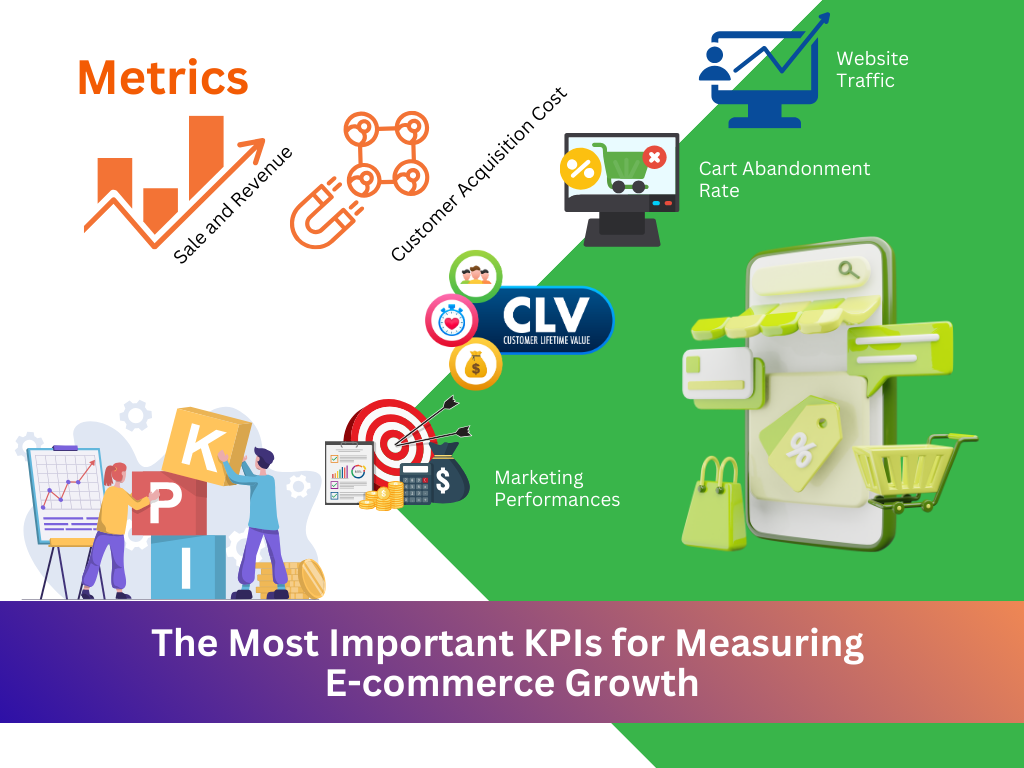
Introduction
Tracking the right Key Performance Indicators (KPIs) is crucial for measuring and optimizing e-commerce growth. By analyzing these metrics, businesses can make data-driven decisions to enhance sales, customer experience, and overall profitability. In this blog, we’ll explore the most important KPIs for e-commerce success and how to use them effectively.
1. Sales & Revenue Metrics
Total Revenue
- Measures the total income generated from sales over a specific period.
- Helps track overall business performance and trends.
Average Order Value (AOV)
- Calculated as Total Revenue ÷ Number of Orders.
- Higher AOV means customers are spending more per transaction.
- Strategies to improve: Upselling, bundling, and discount thresholds.
Conversion Rate
- Percentage of visitors who complete a purchase.
- Formula: (Conversions ÷ Total Visitors) × 100.
- Optimizations: Improve UX, streamline checkout, and offer personalized recommendations.
2. Customer Metrics
Customer Acquisition Cost (CAC)
- Measures the cost of acquiring a new customer.
- Formula: Total Marketing Spend ÷ Number of New Customers.
- Lowering CAC improves profitability.
Customer Lifetime Value (CLV)
- Total revenue expected from a customer throughout their relationship with the brand.
- Formula: (AOV × Purchase Frequency × Customer Lifespan).
- Strategies to improve: Loyalty programs, excellent customer service, and personalized offers.
Cart Abandonment Rate
- Percentage of shoppers who add products to their cart but don’t complete the purchase.
- Formula: (Abandoned Carts ÷ Initiated Checkouts) × 100.
- Reduce it with email reminders, exit-intent popups, and an easy checkout process.
3. Website & Traffic Metrics
Website Traffic
- Total number of visitors to your e-commerce site.
- Key sources: Organic, paid, social, direct, and referral traffic.
- Analyze traffic trends to optimize marketing strategies.
Bounce Rate
- Percentage of visitors who leave without taking any action.
- High bounce rates indicate poor user experience or irrelevant content.
- Improve by optimizing page load speed and enhancing content relevance.
Page Load Speed
- Directly affects user experience and SEO rankings.
- Faster load times improve conversions and reduce bounce rates.
- Optimize images, leverage caching, and use a content delivery network (CDN).
4. Marketing Performance Metrics
Return on Ad Spend (ROAS)
- Measures the effectiveness of advertising campaigns.
- Formula: Revenue from Ads ÷ Ad Spend.
- Higher ROAS indicates efficient ad spend and better profitability.
Email Marketing Performance
- Metrics to track: Open rate, click-through rate (CTR), and unsubscribe rate.
- Personalization and segmentation improve email engagement.
Social Media Engagement
- Track likes, shares, comments, and follower growth.
- Indicates brand awareness and customer interaction.
Monitoring these KPIs is essential for e-commerce growth and success. By consistently analyzing and optimizing these metrics, businesses can improve their marketing efforts, enhance customer experience, and drive more revenue.
